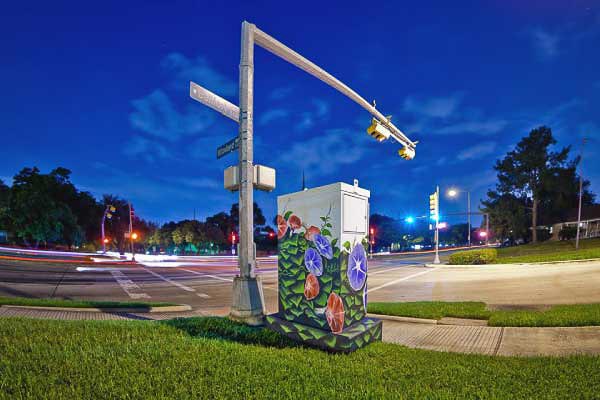Noah Quiles has gone legit.
A Chicago-based graffiti artist in a prior life, Quiles, along with his wife Elia, is now working with Houston city leaders to raise the profile of street artists and bring public art to areas where it's historically been lacking.
This summer, the Quiles - owners of Houston's UP Art Studio - are coordinating the city's "mini-murals" program, in which artists will paint dozens of traffic signal control boxes in southwest Houston.
The metallic structures house the electronic components that control traffic lights at each intersection. They also happen to make a perfect canvases for street artists. "It's simple," Noah said. "This project is for the city. And it's a wild dream come true."
Other cities like Seattle, Los Angeles and Boise, Idaho have transformed their traffic control boxes into murals too. "We didn't create the idea," Noah said. "But we brought it to Houston."
The city owns about 2,400 of the boxes (more are owned by the county and METRO). Artists will paint 31 of them as the first phase of the program.
Eventually, the Quiles say they want to see the program expand further. They envision a longer-term mural program in Houston akin to Philadelphia's Mural Arts Program. "We want this to be our first splash of color in a murals program," Noah said.
The first of the murals debuted earlier this month, and the Quiles say they expect the work to be completed by the end of July. Generally, they're painted relatively quickly - typically in less than two days.
But the process of Houston creating the mini-murals program took much longer.
The city originally began discussing a program to paint traffic boxes about three years ago when deputy public works chief Jeff Weatherford pitched the idea, said Minnette Boesel, the mayor's assistant for cultural affairs.
The boxes, Boesel said, "were getting tagged all the time with graffiti and stickers and posters. It was a real problem. He thought maybe they could be used as a canvas for artwork."
But the project - like many municipal endeavors - stalled due to a lack of funding. The Quiles, working with city officials, knew that city councilmembers had their own pots of money they could direct towards specific projects.
So the Quiles reached out to every councilmember representing a Houston district and found a benefactor in city councilmember Larry Green, who represents District K in the southwest part of Houston. They originally suggested he order 20 of the mini-murals. Instead, he ordered 31. "He sees the value of civic art and our goal to educate, move and delight through art," Noah said. The project costs about $46,500, which covers the cost of materials, overhead, and the artists' fees.
The artists have depicted a wide variety of subjects from wildlife to geometric designs to bicycles in styles that range from realistic to far-out. Program organizers suggested particular themes in each community but largely allowed the artists the freedom to work as they chose, so long as their designs weren't considered offensive.
"They make fantastic palettes for artists to create work," said Sara Kellner, director of the civic art and design program at the Houston Arts Alliance, which also helped coordinate the project. "Each of the artist's vision is so different and unique. It's a project that has a lot of expression."
Thirteen artists are painting the traffic signal boxes. Many of them have created larger works that Houstonians are already familiar with. Sebastien "Mr. D" Boileau, for example, painted his giant take on Michelangelo's The Creation of Adam in Midtown. Anat Ronen painted the space scene on NASA Road 1, visible from I-45 southbound. And artist Dual painted the mural on the side of East End dive bar Voodoo Queen. "They're some of the best that Houston has to offer," Elia Quiles said.
Boesel said the program allows City Hall to help support and promote some of the artists who've helped to shape Houston's identity.
"It's important to our city, in terms of taking something most people feel is an eyesore and making it into a thing of beauty and fun," she said. "We're just thrilled that the city was able to collectively organize this."
Noah added that the project is particularly important because it's concentrated outside of Houston's core, where so far, there hasn't been much of a focus on public art.
Already, other nearby municipalities are contacting the Quiles and asking them about reproducing a version of the mini-murals program outside of Houston's city limits. But they emphasize if the program expands - within Houston or outside of it - only the most talented artists will be chosen to paint the traffic boxes.
"We want to be share we set the bar high," Noah said. "It's high-quality civic art. We want it to be upper-echelon."

